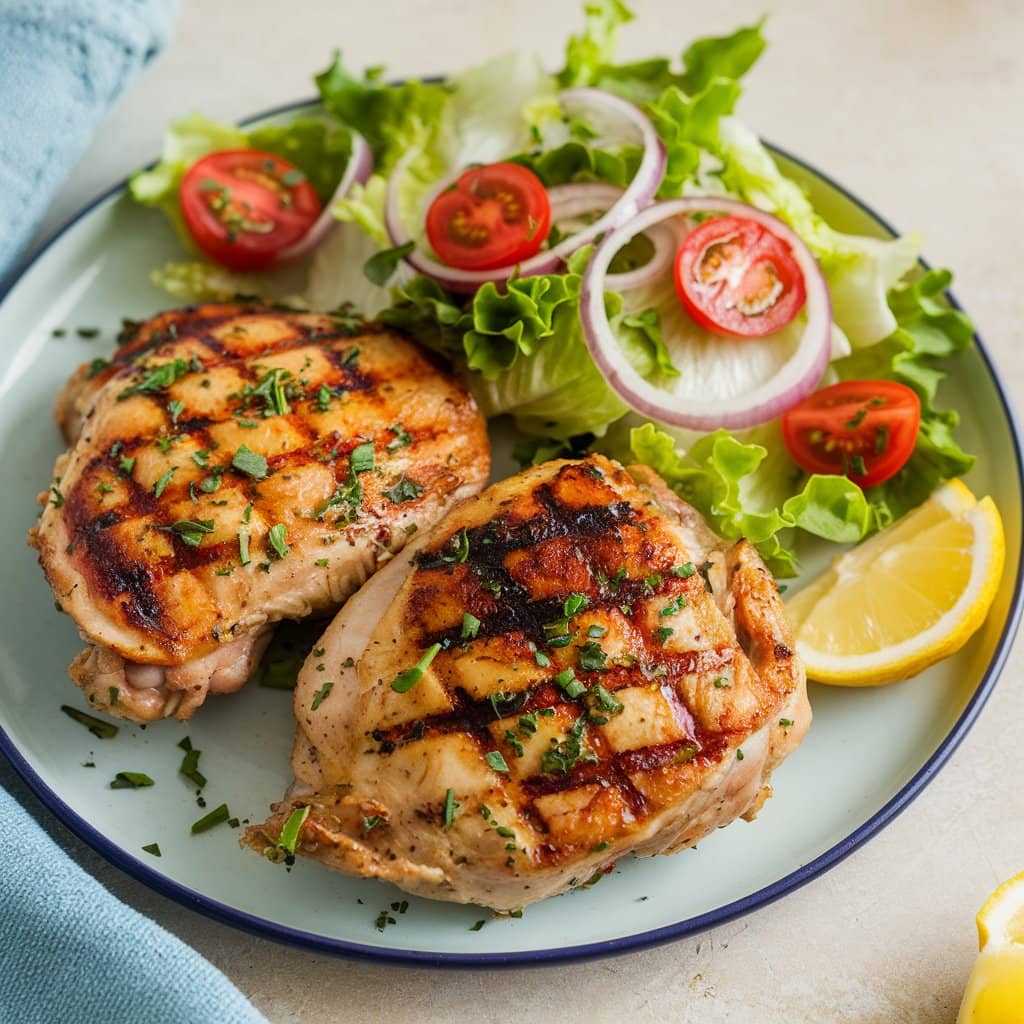If you’ve ever wondered what the best method of cooking chicken thighs is, you’re not alone. Chicken thighs are a flavorful and versatile cut of poultry that can elevate any meal. Whether you crave crispy skin, juicy meat, or smoky, charred flavors, choosing the right technique is essential to achieving perfect results.
From baking and grilling to air frying and slow cooking, there are countless ways to master how to cook chicken thighs. Each method offers unique benefits, allowing you to tailor your preparation to suit your taste and cooking style. This guide explores the best way to cook chicken thighs, provides valuable tips, and ensures your thighs turn out tender, flavorful, and irresistible every time.
For those new to the kitchen or seasoned chefs looking to perfect their techniques, understanding various chicken thigh cooking methods is the key to consistently satisfying results. Whether you’re preparing a quick weekday dinner or a special family feast, you’ll find everything you need to create perfectly cooked chicken thighs in this guide.
Table of contents
Best Cooking Methods for Chicken Thighs
Choosing the best method of cooking chicken thighs is essential to getting the texture, flavor, and juiciness you crave. Whether you prefer crispy, oven-baked chicken thighs or smoky, grilled flavors, understanding the various methods ensures a perfect outcome every time. Let’s explore what makes each approach the best way to cook chicken thighs depending on your preferences.
Baking Chicken Thighs
Baking is widely regarded as the best method of cooking chicken thighs when you want a hassle-free yet flavorful option. The even heat of the oven ensures a golden, crispy skin while keeping the meat tender and juicy.
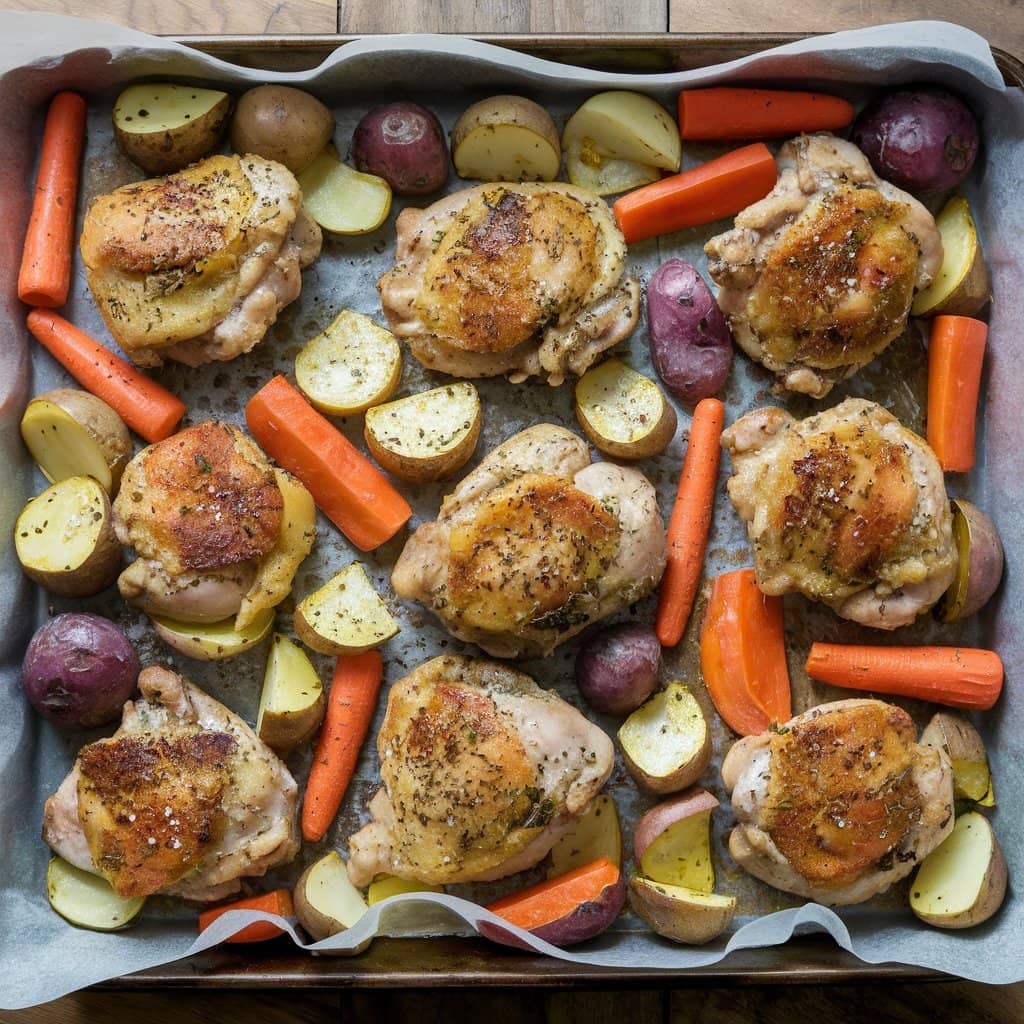
How to Bake Chicken Thighs
- Preheat the Oven: Set your oven to 400°F (200°C), the optimal temperature for perfectly cooked chicken thighs.
- Season the Thighs: Apply a generous mix of salt, pepper, garlic powder, paprika, and olive oil to the thighs for classic flavor.
- Arrange on a Baking Tray: For crispy chicken thighs, use a wire rack over a baking sheet.
- Bake: Cook for 35-45 minutes, depending on the size of the chicken thighs, until the internal temperature reaches 165°F (75°C).
Baking remains one of the best chicken thigh cooking methods because it combines simplicity with consistent, delicious results.
Grilling Chicken Thighs
If you’re craving smoky, charred flavors, grilling might be the best way to cook chicken thighs. This method is perfect for summer BBQs and brings out the natural richness of the thighs.
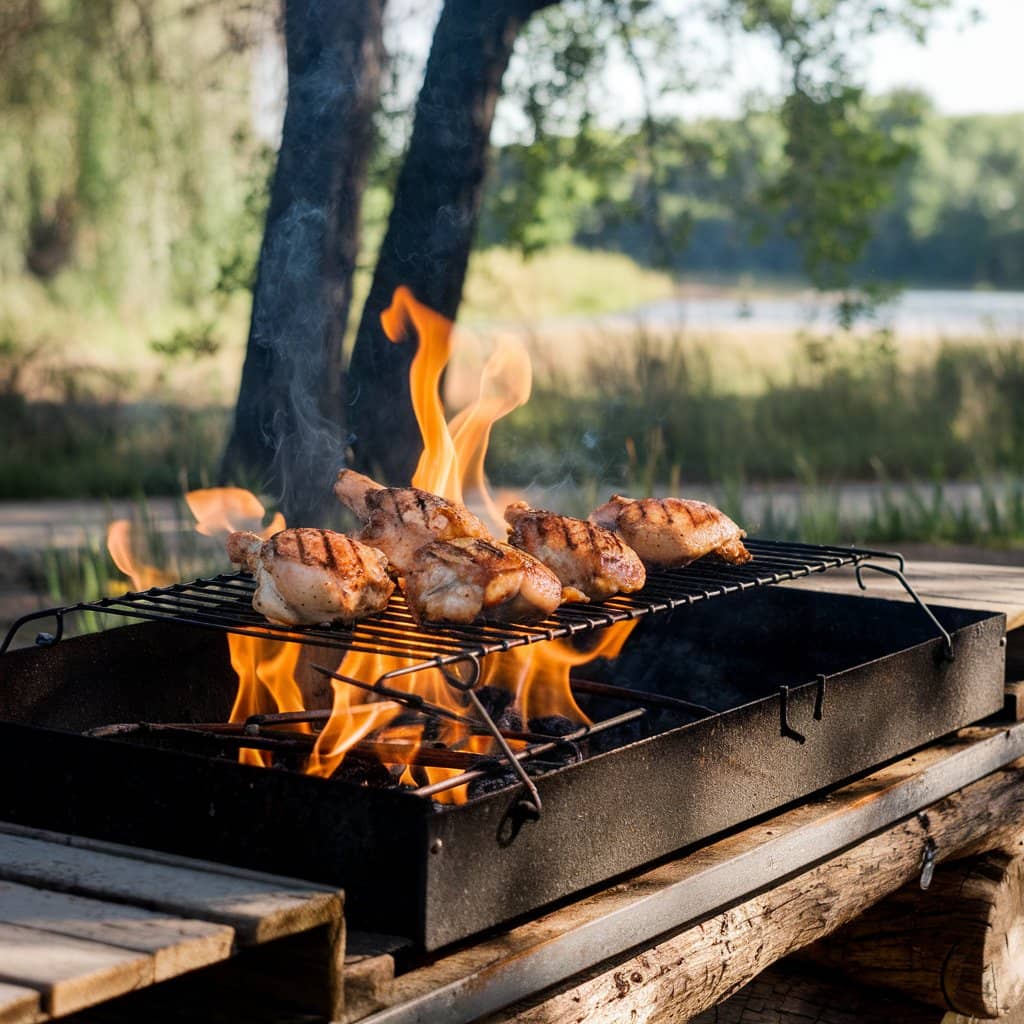
How to Grill Chicken Thighs
- Preheat the Grill: Heat to medium-high for even cooking.
- Marinate the Thighs: Enhance flavor with a marinade of olive oil, herbs, garlic, and a splash of vinegar or lemon juice.
- Grill the Chicken Thighs: Place them skin-side down. Cook for 6-7 minutes per side, ensuring the internal temperature reaches 165°F (75°C).
Many cooks consider grilling one of the best methods of cooking chicken thighs because it locks in the juices while adding a smoky, BBQ-style flavor..
Pan-Frying Chicken Thighs
Pan-frying creates crispy, golden skin and juicy meat, making it a favorite for quick weeknight meals.
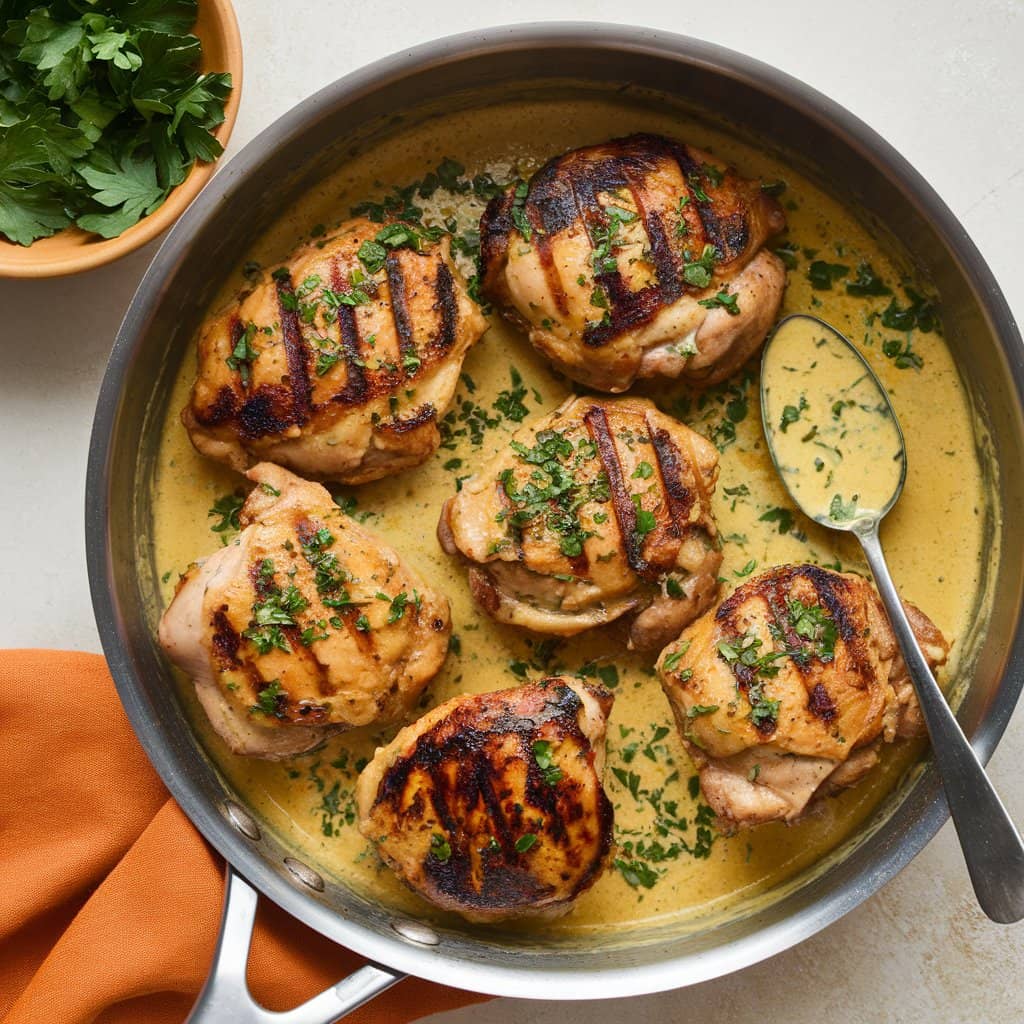
How to Pan-Fry Chicken Thighs:
- Heat the Pan: Use a heavy skillet over medium-high heat with oil or butter.
- Season the Chicken: Pat the thighs dry and season with salt, pepper, and your favorite spices.
- Cook: Start with skin-side down. Sear for 7-8 minutes, then flip and cook for another 6-7 minutes.
Pro Tips for Pan-Frying:
- Avoid crowding the pan for even browning.
- Use a meat thermometer to check doneness.
Slow Cooking Chicken Thighs
Slow cooking is ideal for making tender, fall-off-the-bone chicken thighs with minimal effort. This method works well for bone-in and boneless thighs, perfect for soups, stews, and casseroles.
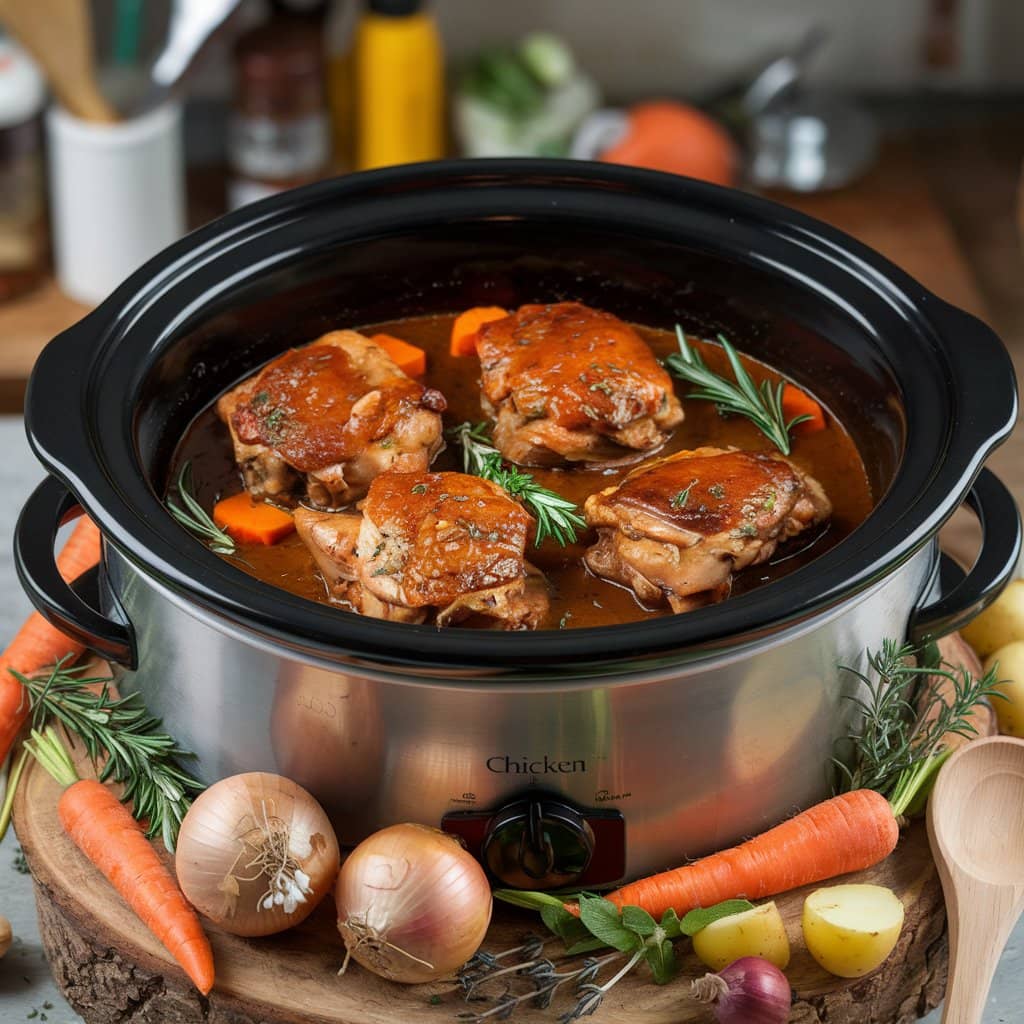
How to Slow Cook Chicken Thighs:
- Prepare the Ingredients: Season the thighs with salt, pepper, garlic powder, and herbs.
- Layer the Slow Cooker: Place chicken thighs at the bottom and add vegetables, broth, or sauce.
- Cook: Set to low for 6-8 hours or high for 3-4 hours until the internal temperature reaches 165°F (75°C).
Pro Tips for Slow Cooking:
- Sear the thighs first for added depth of flavor.
- Avoid lifting the lid during cooking to retain heat.
Air Frying Chicken Thighs
Air frying is perfect for crispy chicken thighs with less oil, making it a healthier yet flavorful option.
How to Air Fry Chicken Thighs:
- Preheat the Air Fryer: Set the temperature to 400°F (200°C).
- Season the Thighs: Use olive oil, salt, pepper, paprika, and garlic powder.
- Air Fry: Place chicken thighs skin-side up in the basket without overlapping. Cook for 20-25 minutes, flipping halfway through.
Pro Tips for Air Frying:
- Pat the chicken dry before seasoning to enhance crispiness.
- Avoid overcrowding to allow air circulation.
Marinades and Seasoning Options
Flavorful marinades elevate chicken thighs, making them juicy and delicious. Here are popular seasoning ideas:
Classic Marinade:
- Olive oil, lemon juice, garlic, rosemary, and thyme.
Spicy Marinade:
- Hot sauce, cayenne pepper, paprika, garlic powder, and lime juice.
Sweet & Savory Marinade:
- Soy sauce, honey, ginger, sesame oil, and rice vinegar.
Tips for Marinating:
- Marinate for at least 30 minutes, or overnight for deeper flavor.
- Use a ziplock bag or airtight container for even coverage.
Cooking Times and Temperatures
Cooking chicken thighs to the right temperature ensures safety and flavor. The USDA recommends an internal temperature of 165°F (75°C) for poultry. Here’s a breakdown of cooking times for different methods:
Cooking Time Guide:
- Baking: 35-45 minutes at 400°F (200°C)
- Grilling: 6-7 minutes per side on medium-high heat
- Pan-Frying: 7-8 minutes per side on medium-high heat
- Slow Cooking: 6-8 hours on low or 3-4 hours on high
- Air Frying: 20-25 minutes at 400°F (200°C)
Tips for Accurate Temperature Checks:
- Use a meat thermometer inserted into the thickest part of the thigh without touching the bone.
- Let the chicken rest for 5-10 minutes after cooking to lock in the juices.
Common Mistakes to Avoid When Cooking Chicken Thighs
Cooking chicken thighs can be incredibly rewarding, but even small missteps can impact the final result. By avoiding these common mistakes, you can ensure your chicken thighs turn out perfectly juicy, tender, and flavorful every time.
1. Overcooking the Chicken
Overcooked chicken thighs lose their juiciness and become tough or dry.
Solution: Use a meat thermometer to monitor the internal temperature. Remove the thighs from heat as soon as they reach 165°F (75°C). Resting the chicken after cooking also helps retain moisture.
2. Underseasoning the Thighs
Chicken thighs have rich, natural flavors, but they still need ample seasoning to shine.
Solution: Use bold seasonings and marinades to complement the natural richness. Incorporate herbs, spices, and acids like lemon or vinegar to balance the flavors.
3. Not Letting the Chicken Rest
Cutting into chicken thighs immediately after cooking can cause the juices to escape, leaving the meat dry.
Solution: Always let the chicken rest for 5-10 minutes before serving. This allows the juices to redistribute throughout the meat.
4. Cooking with Cold Meat
Placing cold chicken thighs directly into a hot pan or oven leads to uneven cooking.
Solution: Allow the chicken to come to room temperature for 20-30 minutes before cooking. This ensures even heat distribution and consistent results.
5. Using the Wrong Heat Level
Incorrect heat levels can result in undercooked centers or overly charred exteriors.
Solution: Adjust the heat based on the cooking method. For pan-frying or grilling, use medium-high heat to sear the outside while cooking the inside evenly. For slow cooking, opt for low heat for tender, fall-off-the-bone results.
How to Keep Chicken Thighs Juicy
Juicy chicken thighs are the result of thoughtful preparation and precise cooking techniques. Here’s how to maximize moisture and tenderness:
1. Use Bone-In, Skin-On Thighs
Bone-in, skin-on thighs retain moisture better than boneless, skinless ones during cooking. The skin also adds extra flavor and crispiness.
2. Marinate Before Cooking
Marinating chicken thighs with acidic ingredients like lemon juice, yogurt, or vinegar helps tenderize the meat while infusing it with flavor.
3. Sear First (If Applicable)
Searing chicken thighs creates a crust that locks in the juices, particularly when baking or slow cooking.
4. Avoid Overcooking
Keep a close eye on the internal temperature. Once the thighs reach 165°F (75°C), remove them from the heat source to prevent dryness.
5. Rest After Cooking
Letting chicken thighs rest after cooking allows the juices to redistribute evenly throughout the meat, ensuring every bite is moist and flavorful.
Health Benefits of Chicken Thighs
Chicken thighs are a flavorful and versatile protein source that also offer numerous health benefits. While they contain slightly more fat than chicken breasts, they are packed with essential nutrients that support overall health. When cooked using healthy methods, chicken thighs can be a nutritious addition to a balanced diet.
Nutritional Profile of Chicken Thighs
1. High-Quality Protein
Chicken thighs are an excellent source of high-quality protein, which is essential for:
- Building and repairing muscles.
- Supporting healthy skin, hair, and nails.
- Maintaining a strong immune system.
2. Rich in Vitamins and Minerals
Chicken thighs provide important vitamins and minerals, including:
- Vitamin B6 and B12: Boost energy metabolism, support nerve function, and improve brain health.
- Niacin: Promotes healthy skin and aids in digestion.
- Iron and Zinc: Strengthen the immune system and assist in the production of red blood cells.
3. Healthy Fats
The fat in chicken thighs includes monounsaturated and polyunsaturated fats, which are known for their heart health benefits, such as:
- Lowering bad cholesterol (LDL).
- Supporting brain function and hormone production.
Health Tips for Cooking Chicken Thighs
To maximize the nutritional value of chicken thighs while minimizing unhealthy elements, follow these tips:
1. Choose Skinless Thighs
Removing the skin reduces the fat content significantly, making the meal lighter without sacrificing the rich flavor of the meat.
2. Opt for Healthy Cooking Methods
- Baking: Bake chicken thighs to retain their natural moisture while reducing the need for additional oil.
- Air Frying: This method creates a crispy exterior with minimal fat, making it an excellent alternative to frying.
3. Watch Your Portions
Stick to recommended serving sizes (about 3-4 ounces per serving) to ensure a balanced intake of calories and nutrients.
4. Add Nutrient-Dense Ingredients
Pair chicken thighs with vegetables, whole grains, or legumes to create a well-rounded, healthful meal.
Why Choose Chicken Thighs Over Chicken Breasts?
While chicken breasts are leaner, chicken thighs provide superior flavor and are less likely to dry out during cooking. They also contain more vitamins and minerals, particularly iron and zinc, making them an excellent choice for individuals needing these nutrients.
By preparing chicken thighs thoughtfully and balancing them with healthy sides, you can enjoy their rich flavor and reap their many health benefits without guilt.
Recipes for Different Tastes
Chicken thighs adapt well to various cuisines and flavor profiles. Here are some globally inspired recipe ideas:
1. Mediterranean Herb Chicken Thighs
- Ingredients: Olive oil, lemon juice, garlic, rosemary, thyme.
- Cooking Method: Bake at 400°F (200°C) for 40 minutes.
2. Spicy Buffalo Chicken Thighs
- Ingredients: Hot sauce, cayenne pepper, paprika, butter.
- Cooking Method: Grill on medium-high heat for 6-7 minutes per side.
3. Asian Soy-Ginger Chicken Thighs
- Ingredients: Soy sauce, ginger, honey, garlic, sesame oil.
- Cooking Method: Pan-fry on medium heat for 8-10 minutes per side.
4. Slow-Cooked BBQ Chicken Thighs
- Ingredients: BBQ sauce, brown sugar, apple cider vinegar, smoked paprika.
- Cooking Method: Slow-cook on low for 6-8 hours.
Serving Suggestions
Pairing chicken thighs with the right sides elevates the meal experience. Consider these delicious serving options:
Classic Sides:
- Mashed Potatoes: Creamy and filling.
- Steamed Vegetables: Broccoli, carrots, or green beans.
- Rice or Quinoa: Perfect for soaking up flavorful sauces.
Healthy Alternatives:
- Salads: A fresh green salad with vinaigrette.
- Roasted Sweet Potatoes: Naturally sweet and nutrient-rich.
- Zucchini Noodles: A low-carb option for pasta lovers.
Presentation Tips:
- Sprinkle freshly chopped herbs like parsley or cilantro.
- Add a wedge of lemon for extra brightness.
- Serve family-style on a large platter for a warm, inviting touch.
Tips for Meal Prepping with Chicken Thighs
Meal prepping with chicken thighs can save time, reduce stress, and ensure you have delicious, healthy meals ready throughout the week. Here’s how to incorporate chicken thighs into your meal prep routine:
Why Use Chicken Thighs for Meal Prep?
- Long-Lasting Juiciness: Chicken thighs remain moist and tender even after reheating, unlike chicken breasts, which can dry out.
- Versatility: They work well in various cuisines such as Mediterranean, Asian, and Mexican.
- Budget-Friendly: Chicken thighs are often cheaper than other cuts of meat.
Meal Prep Steps with Chicken Thighs:
- Plan Your Menu:
- Decide on 2-3 different recipes to keep meals interesting throughout the week.
- Choose recipes that use similar ingredients to save on grocery costs.
- Batch Cooking Methods:
- Baking: Bake a large batch of seasoned thighs on a sheet pan.
- Slow Cooking: Make a stew, curry, or shredded chicken for tacos or bowls.
- Grilling: Grill multiple thighs at once for a smoky, charred flavor.
- Portion and Store:
- Use airtight containers to portion out meals with sides like rice, veggies, or salads.
- Store in the refrigerator for up to 4 days or freeze for longer storage (up to 3 months).
- Reheating Tips:
- Microwave: Cover with a damp paper towel to prevent drying out.
- Oven: Reheat at 350°F (175°C) for 15-20 minutes for crispy skin.
- Stovetop: Sauté in a skillet for 5-7 minutes for a freshly cooked feel.
Sample Meal Prep Ideas:
- Chicken Thigh Burrito Bowls:
- Ingredients: Grilled chicken thighs, brown rice, black beans, corn, salsa, and avocado.
- Mediterranean Chicken Thigh Salad:
- Ingredients: Baked chicken thighs, mixed greens, cucumber, tomatoes, olives, and feta cheese.
- Asian-Inspired Chicken Stir-Fry:
- Ingredients: Pan-fried chicken thighs, bell peppers, broccoli, and teriyaki sauce over jasmine rice.
- BBQ Chicken Thigh Wraps:
- Ingredients: Slow-cooked BBQ chicken thighs, coleslaw, and pickles wrapped in tortillas.
FAQs About Cooking Chicken Thighs
Here are some frequently asked questions about cooking chicken thighs, along with expert answers to ensure your meals turn out perfectly.
1. What Is the Best Way to Season Chicken Thighs?
Seasoning depends on personal preference. A classic blend includes salt, pepper, garlic powder, and paprika. For bolder flavors, try marinades with citrus, soy sauce, or herbs like rosemary and thyme.
2. Should I Use Bone-In or Boneless Chicken Thighs?
Both are excellent choices. Bone-in thighs are juicier and more flavorful, while boneless thighs cook faster and are easier to use in stir-fries, tacos, and pasta dishes.
3. How Do I Know When Chicken Thighs Are Fully Cooked?
Use a meat thermometer. Chicken thighs are safe to eat when the internal temperature reaches 165°F (75°C). Insert the thermometer into the thickest part of the thigh without touching the bone.
4. Why Are My Chicken Thighs Dry?
Overcooking is the main cause of dry chicken thighs. Use a thermometer to monitor the internal temperature and remove the thighs from the heat when they hit 165°F. Resting them for 5-10 minutes also helps retain moisture.
5. How Long Should I Marinate Chicken Thighs?
Marinate for at least 30 minutes to enhance flavor. For deeper flavor, marinate overnight, but avoid going beyond 24 hours, as the meat could become mushy.
6. Can I Cook Chicken Thighs From Frozen?
Yes, but adjust cooking times. For baking, add 15-20 minutes to the usual cook time. Always check the internal temperature to ensure it reaches 165°F (75°C).
Conclusion
When it comes to finding the best method of cooking chicken thighs, the possibilities are endless. From baking and grilling to slow cooking and air frying, each method offers distinct advantages for achieving juicy, tender, and flavorful results. Your choice will depend on your cooking preferences, the tools you have available, and the texture or flavor profile you desire.
Whether you’re looking to learn how to cook chicken thighs for a quick weeknight dinner or want to perfect a slow-cooked recipe for a family gathering, experimenting with different techniques will help you discover what works best for your taste. Baking and air frying deliver crispy skin with minimal effort, while grilling adds a smoky depth. Slow cooking, on the other hand, is ideal for tender, fall-off-the-bone meat.
By mastering various chicken thigh cooking methods, you can ensure every meal is a success. Remember to use seasonings or marinades for enhanced flavor, avoid common mistakes like overcooking, and focus on retaining moisture for the most satisfying results. With these tips, you’ll always enjoy perfectly cooked chicken thighs.

